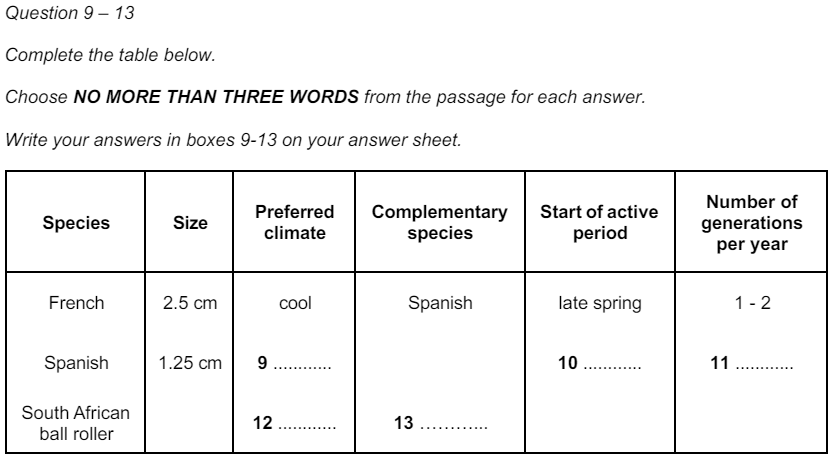Introduction
In the IELTS reading table completion task, you must complete the blanks in a table by reading and finding the correct answers from a given text.
IELTS Reading table completion sample task
[Note: This is an extract from an Academic Reading passage on the subject of dung beetles.
The text preceding this extract gave some background facts about dung beetles, and went
on to describe a decision to introduce non-native varieties to Australia.]
Introducing dung beetles into a pasture is a simple process: approximately 1,500 beetles
are released, a handful at a time, into fresh cow pats in the cow pasture. The beetles
immediately disappear beneath the pats digging and tunnelling and, if they successfully
adapt to their new environment, soon become a permanent, self-sustaining part of the
local ecology. In time they multiply and within three or four years the benefits to the
pasture are obvious.
Dung beetles work from the inside of the pat so they are sheltered from predators such
as birds and foxes. Most species burrow into the soil and bury dung in tunnels directly
underneath the pats, which are hollowed out from within. Some large species originating
from France excavate tunnels to a depth of approximately 30 cm below the dung pat.
These beetles make sausage-shaped brood chambers along the tunnels. The shallowest
tunnels belong to a much smaller Spanish species that buries dung in chambers that hang
like fruit from the branches of a pear tree. South African beetles dig narrow tunnels of
approximately 20 cm below the surface of the pat. Some surface-dwelling beetles,
including a South African species, cut perfectly-shaped balls from the pat, which are
rolled away and attached to the bases of plants.
For maximum dung burial in spring, summer and autumn, farmers require a variety of
species with overlapping periods of activity. In the cooler environments of the state of
Victoria, the large French species (2.5 cms long), is matched with smaller (half this size),
temperate-climate Spanish species. The former are slow to recover from the winter cold
and produce only one or two generations of offspring from late spring until autumn. The
latter, which multiply rapidly in early spring, produce two to five generations annually.
The South African ball-rolling species, being a sub-tropical beetle, prefers the climate of
northern and coastal New South Wales where it commonly works with the South
African tunneling species. In warmer climates, many species are active for longer periods
of the year.
Source: Official IELTS website www.https://ielts.org

Source: Official IELTS website www.https://ielts.org
IELTS Reading Table completion tips
Answers in the text will appear in a different order than the table
The information in the table will appear in a different order than the information given in the text.
Don’t use synonyms to fill blanks
To complete the table you must use the exact words from the given text. Otherwise, your answer will be marked wrong.
Headings from the table might appear as synonyms in the text
Don’t try to look for a word-to-word match for the headings from the table as synonyms or similar meaning words might be used. Try to focus on the meaning of what is being asked in a particular column.
Avoid grammatical mistakes
When completing the table ensure that the sentences are grammatically correct. Only correct answers will be grammatically correct.
IELTS reading table completion strategy
Read the question
Read the question carefully to see how many words are needed to answer the question. As per the example above, select NO MORE THAN THREE WORDS from the passage. If you choose more than three words you will lose marks.
Look for clues in the table
Look at the table carefully and identify any clues from the column headings and the information in each row before and after the blanks. This will give context to what you need to search for in the text.
Skim the text
Skim through the text to understand the meaning of each paragraph. You need to focus on what each paragraph conveys. This understanding of the topic of the text and each paragraph will come in handy when you search for the answers in the next steps.
Read the Table row
Read the table row which has the gap. Try to understand the meaning of the sentence and identify keywords. You will use these keywords to search the text for the correct answers.
Read the text
When you skimmed the text earlier, you identified each paragraph’s meaning. Use that knowledge to search for the keywords needed to fill the gap in the table row.
Check your answer
Check your answer to make sure it is grammatically correct.
Correct answers
9 temperate
10 early spring
11 two to five
12 sub-tropical
13 South African tunnelling
Work out the answers
I started by analysing the table for clues by reading through the headings and then rows to understand the meaning. Next, I started skimming through the given text to understand the general topic and the topic of each paragraph. Then, I read the first table row to understand the meaning. There are no blanks in the first row so it can be used as an example to fill the second row.
By looking at the table and skimming the text I gathered that the main topic is the introduction of dung beetle in a pasture. The table compares the various species of the dung beetle based on their size, preferred climate, complimentary species, start of active period and number of generations per year.
9. The first blank is on the second row for identifying the preferred climate of the Spanish dung beetle.
The mention of the preferred climate by the Spanish dung beetle comes first in the last paragraph. They prefer a temperate climate. temperate is the correct answer.
In the cooler environments of the state of Victoria, the large French species (2.5 cms long), is matched with smaller (half this size), temperate-climate Spanish species.
10. The second blank is for identifying the active period of the Spanish dung beetle.
The Mention of the Spanish dung beetle multiplying rapidly is a synonym for their active period. They are active in early spring, which is the correct answer.
The large French species (2.5 cms long), is matched with smaller (half this size), temperate-climate Spanish species. The former are slow to recover from the winter cold and produce only one or two generations of offspring from late spring until autumn. The latter, which multiply rapidly in early spring.
11. The third blank is for identifying the number of generations per year for the Spanish dung beetle.
The latter in the paragraph’s last sentence refers to the Spanish dung beetle, which produces two to five generations annually. two to five is the answer to this.
The large French species (2.5 cms long), is matched with smaller (half this size), temperate-climate Spanish species. The former are slow to recover from the winter cold and produce only one or two generations of offspring from late spring until autumn. The latter, which multiply rapidly in early spring, produce two to five generations annually.
12. The fourth blank is in the last row for identifying the preferred climate for the South African boll rolling beetle.
In the last paragraph, it mentions that the South African ball-rolling species is sub-tropical. Hence sub-tropical is the correct answer.
The South African ball-rolling species, being a sub-tropical beetle
13. The fifth and last blank is for identifying the complimentary species of the South African ball roller beetle.
In the last paragraph, it mentions that the South African ball-rolling beetle commonly works with South African species. Observe how commonly works has been used as a synonym for complementary species. South African tunnelling is the correct answer.
The South African ball-rolling species, being a sub-tropical beetle, prefers the climate of northern and coastal New South Wales where it commonly works with the South African tunneling species.
